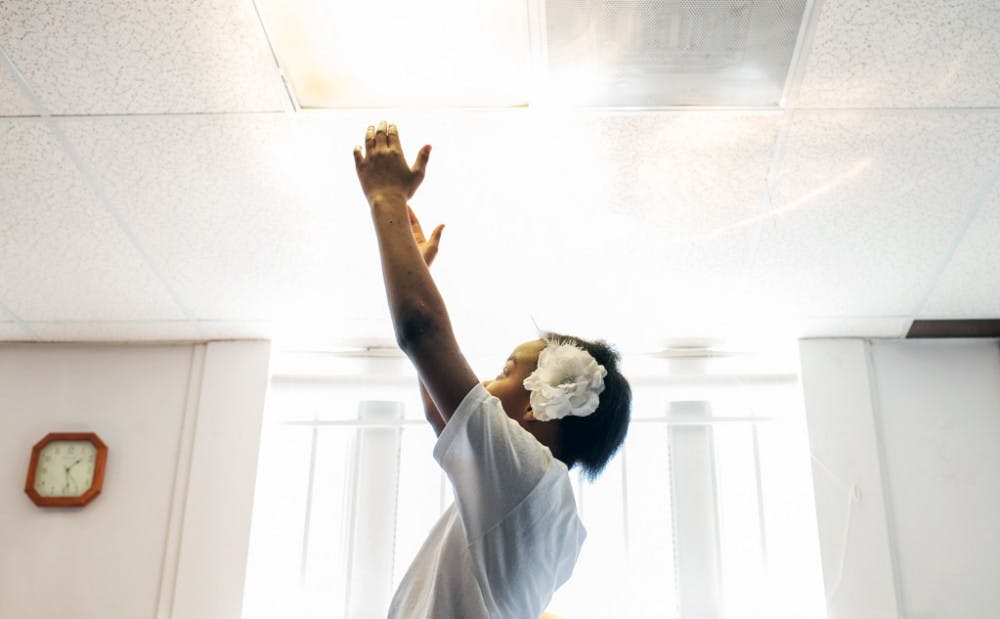Storefront churches have always been a part of Kristin Bedford’s landscape. On her way to the bus stop or the candy store, she’d see the D.C. church signs, handmade and painted onto windows. Like so many other visuals in her life, these have stayed with her, footnoting themselves into her mind; this Thursday, September 12, is the opening reception for “Be Still: A Storefront Church in Durham.”
Kristin Bedford takes pictures. 'Makes' pictures, if you’re from the South. She vaguely recalls a black and white photography book that was somehow connected to a Sanford School of Public Policy, and that’s more or less how she ended up in the MFA program at Duke. After living in Los Angeles for seven years—for love and sunshine—she arrived in Durham a month before her program began. With the memory of a book she read as a religious studies major (Arthur Fauset’s “Black Gods of the Metropolis”), Bedford set out to investigate what it meant to photograph faith.
It started as a series of all-day experiences. She figured out how to visit three or four storefront churches in one day, which was easy enough in a place where church ran all morning, noon and night. She chose one church with a certain Pastor Dubois. “I really liked his disposition. He was charismatic and generous. But he wasn’t dogmatic. There was roominess in his conversation, his dialogue in religion.”
So Bedford went to church from August of 2012 to April of 2013, taking photographs every Sunday. She was introduced in sermons: “This is sister Kristin. If you haven’t had your picture taken by her yet, you will before you leave. She takes pictures of you standing up, praying, against the wall, laying down…She’s there.”
Soon, Bedford became a part of the church’s fabric. She never intruded. She was either at a seated level or on the ground, making a point to never stand up and look down at people through her lens. She focused on capturing moments of serenity, of candidness: a young girl twirling; flowers and a comb in the bathroom; church members swimming in Falls Lake; a man in the back of the church (“I don’t know what he’s doing—he’s just having this moment alone.”).
“You’re ingratiated when you’ve taken the time to know who they are. People will respond to that…I had a quieter presence. I would sit for long periods of time before I would take a picture. I would wait before the moment arose."
Bedford started young. She was exposed early to the world of photography; her father, a documentary filmmaker, was very interested in her visually telling stories. He presented Bedford with a point-and-shoot camera when she was five. Every so often, she’d graduate to a new camera—always film.
“[My father] wasn’t somebody who would tell me what was right or wrong or good or bad. We would generate a dialogue, talk about what’s going on in the picture.”
Along with the camera came a tradition. On special occasions, Bedford’s father would give her a book, usually dedicated to a single photographer—Margaret Bourke-White is still Bedford’s greatest influence. Some of the only things she owned as a child, these books would soon inform her own process, stimulating a visual exchange between what Bedford was doing and what these artists were doing. She was impressed upon by anything she owned or encountered.
“We were poor, but the Smithsonian is free. My father and I would spend a lot of time talking about the art in the museum—Calder, Rothko, Noguchi. That’s where I came out of. The cultural exposure my father gave me was second-to-none,” said Bedford. “It was this very quiet and homemade spirit of independent education.”
Bedford recollected amusedly on her Bohemian upbringing, surrounded by those who had dedicated their lives to their artwork. She had met Andy Warhol and Basquiat in a restaurant. “I knew who Warhol was, so I picked up my cloth napkin and introduced myself. I told them that I was a photographer—I was seven!—and they asked what kind. I said I liked taking pictures on the street, and they asked me if I liked Gary Winogrand.” Then Warhol opened up his jacket, pulled out a Sharpie and signed Bedford’s napkin.
After decades of creating pictures and despite wanting to teach and continue with longer-term projects, Bedford never feels comfortable when labeled a photographer. “The world wants you to be in a category,” she said. If she were in a category, she decided it would best be termed the ‘documentary arts.’ “Essentially, you’re entering a situation as a storyteller, but you have the liberties of an artist…But any category seems strange to me. I take pictures.”
Twenty-five of Bedford’s pictures are displayed for the “Be Still” exhibition. Some are larger than others, but all are poignant and earnest to share. Like the storefront churches, which are stripped from elements of architecture and decoration, Bedford’s compelling images delve into faith, celebrating our quiet glimpses into stillness.
“I hope that people take the time to be present…To actually see materiality is a joy,” said Bedford. “My hope is that people would take the time to look.”
“Be Still: A Storefront Church in Durham” is on display in the Allen Building Gallery, 2nd Floor, until December 13. The opening reception is tonight, September 12, from 5:30 to 7 p.m. To see more works by Kristin Bedford, visit Bedford's website here.
Get The Chronicle straight to your inbox
Signup for our weekly newsletter. Cancel at any time.

